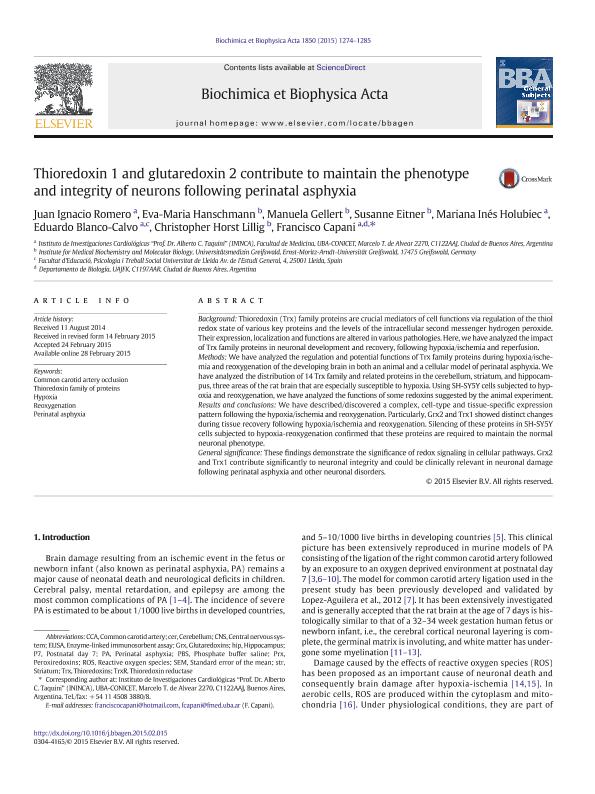Mostrar el registro sencillo del ítem
dc.contributor.author
Romero, Juan Ignacio

dc.contributor.author
Hanschmann, Eva Maria
dc.contributor.author
Gellert, Manuela
dc.contributor.author
Eitner, Susanne
dc.contributor.author
Holubiec, Mariana Ines

dc.contributor.author
Blanco Calvo, Eduardo
dc.contributor.author
Lillig, Christopher Horst
dc.contributor.author
Capani, Francisco

dc.date.available
2018-03-06T14:34:51Z
dc.date.issued
2015-06
dc.identifier.citation
Romero, Juan Ignacio; Hanschmann, Eva Maria; Gellert, Manuela; Eitner, Susanne; Holubiec, Mariana Ines; et al.; Thioredoxin 1 and glutaredoxin 2 contribute to maintain the phenotype and integrity of neurons following perinatal asphyxia; Elsevier Science; Biochimica et Biophysica Acta- General Subjects; 1850; 6; 6-2015; 1274-1285
dc.identifier.issn
0304-4165
dc.identifier.uri
http://hdl.handle.net/11336/37942
dc.description.abstract
Background Thioredoxin (Trx) family proteins are crucial mediators of cell functions via regulation of the thiol redox state of various key proteins and the levels of the intracellular second messenger hydrogen peroxide. Their expression, localization and functions are altered in various pathologies. Here, we have analyzed the impact of Trx family proteins in neuronal development and recovery, following hypoxia/ischemia and reperfusion. Methods We have analyzed the regulation and potential functions of Trx family proteins during hypoxia/ischemia and reoxygenation of the developing brain in both an animal and a cellular model of perinatal asphyxia. We have analyzed the distribution of 14 Trx family and related proteins in the cerebellum, striatum, and hippocampus, three areas of the rat brain that are especially susceptible to hypoxia. Using SH-SY5Y cells subjected to hypoxia and reoxygenation, we have analyzed the functions of some redoxins suggested by the animal experiment. Results and conclusions We have described/discovered a complex, cell-type and tissue-specific expression pattern following the hypoxia/ischemia and reoxygenation. Particularly, Grx2 and Trx1 showed distinct changes during tissue recovery following hypoxia/ischemia and reoxygenation. Silencing of these proteins in SH-SY5Y cells subjected to hypoxia-reoxygenation confirmed that these proteins are required to maintain the normal neuronal phenotype. General significance These findings demonstrate the significance of redox signaling in cellular pathways. Grx2 and Trx1 contribute significantly to neuronal integrity and could be clinically relevant in neuronal damage following perinatal asphyxia and other neuronal disorders.
dc.format
application/pdf
dc.language.iso
eng
dc.publisher
Elsevier Science

dc.rights
info:eu-repo/semantics/openAccess
dc.rights.uri
https://creativecommons.org/licenses/by-nc-sa/2.5/ar/
dc.subject
Common Carotid Artery Occlusion
dc.subject
Hypoxia
dc.subject
Perinatal Asphyxia
dc.subject
Reoxygenation
dc.subject
Thioredoxin Family of Proteins
dc.subject.classification
Otras Ciencias Biológicas

dc.subject.classification
Ciencias Biológicas

dc.subject.classification
CIENCIAS NATURALES Y EXACTAS

dc.title
Thioredoxin 1 and glutaredoxin 2 contribute to maintain the phenotype and integrity of neurons following perinatal asphyxia
dc.type
info:eu-repo/semantics/article
dc.type
info:ar-repo/semantics/artículo
dc.type
info:eu-repo/semantics/publishedVersion
dc.date.updated
2018-03-05T20:42:15Z
dc.journal.volume
1850
dc.journal.number
6
dc.journal.pagination
1274-1285
dc.journal.pais
Países Bajos

dc.journal.ciudad
Amsterdam
dc.description.fil
Fil: Romero, Juan Ignacio. Consejo Nacional de Investigaciones Científicas y Técnicas. Oficina de Coordinación Administrativa Houssay. Instituto de Investigaciones Cardiológicas. Universidad de Buenos Aires. Facultad de Medicina. Instituto de Investigaciones Cardiológicas; Argentina
dc.description.fil
Fil: Hanschmann, Eva Maria. Universitätsmedizin Greifswald; Alemania
dc.description.fil
Fil: Gellert, Manuela. Universitätsmedizin Greifswald; Alemania
dc.description.fil
Fil: Eitner, Susanne. Universitätsmedizin Greifswald; Alemania
dc.description.fil
Fil: Holubiec, Mariana Ines. Consejo Nacional de Investigaciones Científicas y Técnicas. Oficina de Coordinación Administrativa Houssay. Instituto de Investigaciones Cardiológicas. Universidad de Buenos Aires. Facultad de Medicina. Instituto de Investigaciones Cardiológicas; Argentina
dc.description.fil
Fil: Blanco Calvo, Eduardo. Consejo Nacional de Investigaciones Científicas y Técnicas. Oficina de Coordinación Administrativa Houssay. Instituto de Investigaciones Cardiológicas. Universidad de Buenos Aires. Facultad de Medicina. Instituto de Investigaciones Cardiológicas; Argentina. Universidad de Lleida; España
dc.description.fil
Fil: Lillig, Christopher Horst. Universitätsmedizin Greifswald; Alemania
dc.description.fil
Fil: Capani, Francisco. Consejo Nacional de Investigaciones Científicas y Técnicas. Oficina de Coordinación Administrativa Houssay. Instituto de Investigaciones Cardiológicas. Universidad de Buenos Aires. Facultad de Medicina. Instituto de Investigaciones Cardiológicas; Argentina. Universidad Argentina "John F. Kennedy"; Argentina
dc.journal.title
Biochimica et Biophysica Acta- General Subjects

dc.relation.alternativeid
info:eu-repo/semantics/altIdentifier/doi/http://dx.doi.org/10.1016/j.bbagen.2015.02.015
dc.relation.alternativeid
info:eu-repo/semantics/altIdentifier/url/https://www.sciencedirect.com/science/article/pii/S030441651500077X
Archivos asociados
